Automatic Heating and Air Conditioning System (Climate Control)
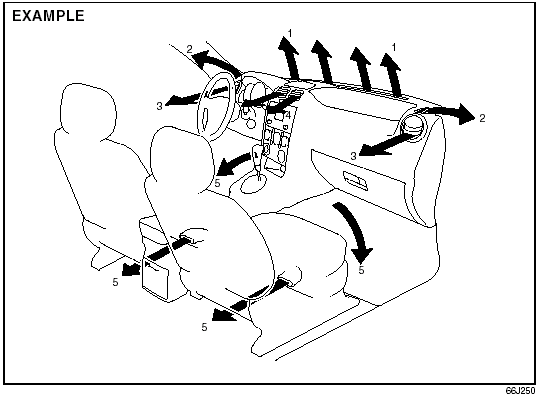
Air Outlet (front)
1. Windshield defroster outlet
2. Side defroster outlet
3. Side outlet
4. Center outlet
5. Floor outlet
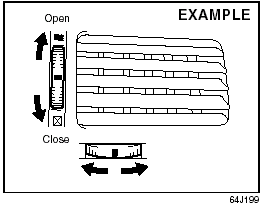
Center outlet
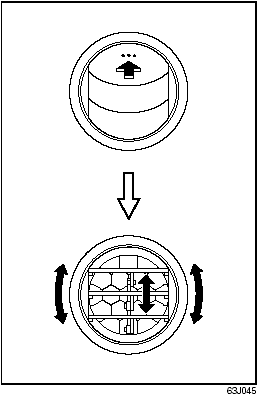
Side outlet
When “Open”, air comes out from the side outlets regardless of the air flow selector position.
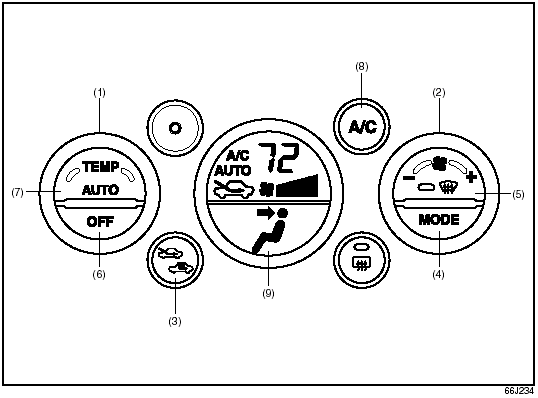
Description of Controls
(1) Temperature selector
(2) Blower speed selector
(3) Air intake selector
(4) Air flow selector
(5) Defrost switch
(6) “OFF” switch
(7) “AUTO” switch
(8) Air conditioning switch
(9) LCD display
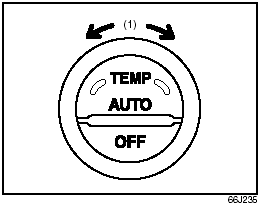
Temperature selector (1)
Turn this selector to adjust the temperature.
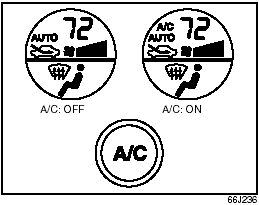
Air conditioning switch (8)
This switch is used to turn on and off the air conditioning system. To turn on the air conditioning system, push in the switch and “A/C” will appear on the LCD display.
To turn off the air conditioning system, push in the switch again and “A/C” will go off.
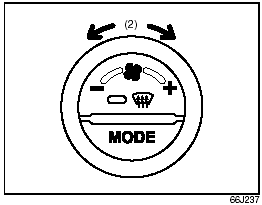
Blower speed selector (2)
This selector is used to turn on the blower and to select blower speed.
If the “AUTO” switch (7) is pushed, the blower speed will vary automatically as the climate control system maintains the selected temperature.
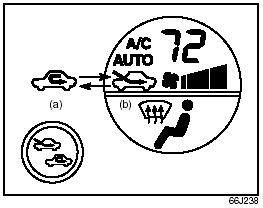
Air intake selector (3)
Push this selector to change between the following modes.
RECIRCULATED AIR (a)
When this mode is selected, outside air is shut off and inside air is recirculated. This mode is suitable when driving through an area with polluted air such as a tunnel, or when attempting to quickly cool down the vehicle.
FRESH AIR (b)
When this mode is selected, outside air is introduced.
“FRESH AIR” and “RECIRCULATED AIR” are selected alternately each time the air intake selector is pushed.
NOTE:
If you select “RECIRCULATED AIR” for an
extended period of time, the air in the vehicle
can become contaminated. Therefore,
you should occasionally select “FRESH
AIR”.
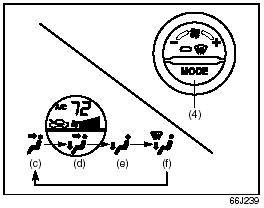
Air flow selector (4)
Push this selector to change among the following functions. The indication of the selected mode appears on the LCD display.
AUTO (7)
Temperature-controlled air comes out of various outlets automatically.
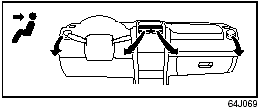
Ventilation (c)
Temperature-controlled air comes out of the center and side air outlets.
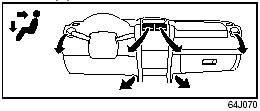
Bi-level (d)
Temperature-controlled air comes out of the floor outlets and cooler air comes out of the center and side outlets. When the temperature selector (1) is in the fully COLD position or fully HOT position, however, the air from the floor outlets and the air from the center and side outlets will be the same temperature.
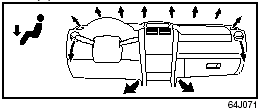
Heat (e)
Temperature-controlled air comes out of the floor outlets and the side outlets, a small amount of air comes out of the windshield defroster outlets and the side defroster outlets.
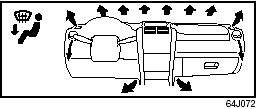
Heat & defrost (f)
Temperature-controlled air comes out of the floor outlets, the windshield defroster outlets, the side defroster outlets and the side outlets.
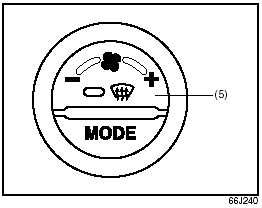
Defrost switch (5)
Push this switch to turn on the defroster.
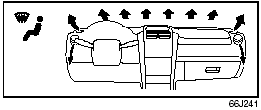
Defrost
Temperature-controlled air comes out of the windshield defroster outlets, the side defroster outlets and the side outlets.
NOTE:
When the defrost switch (5) is pushed to
turn on the defroster, the air conditioning
system will come on and the “FRESH AIR”
mode will be selected automatically. In
very cold weather, however, the air conditioning
system will not turn on.
System Operating Instructions
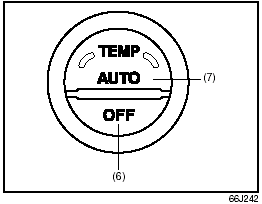
Automatic operation
You can let the climate control system work automatically. To set the system for fullyautomatic operation, follow the procedure below.
1) Set the desired temperature by turning the temperature selector (1).
2) Push the “AUTO” switch (7).
The blower speed selector (2), air intake selector (3), and air flow selector (4) are controlled automatically to maintain the set temperature.
You can use the air conditioning switch (8) to manually turn the air conditioner on or off according to your preference. When you turn the air conditioning switch off, the climate control system cannot lower the inside temperature below outside temperature.
To turn the climate control system off, push the “OFF” switch (6).
NOTE:
If the “AUTO” on the LCD display blinks,
there is a problem in the heating system
and/or air conditioning system. You should
have the system inspected by an authorized
SUZUKI dealer.
NOTE:
• To find the temperature at which you are
most comfortable, start with the 22°C
(72°F) setting.
• If you turn the temperature selector (1) until “HI” or “LO” appears on the LCD display, the climate control system will operate at the maximum cooling or heating and the blower will run at full speed.
• To avoid blowing cold air in cold weather or hot air in hot weather, the system will delay turning on the blower until warmed or chilled air is available.
• If your vehicle has been left in the sun with the windows closed, it will cool faster if you open the windows briefly.
• Even under the automatic operation, you can set individual selectors to the manual mode. The manually selected functions are maintained, and the other functions remain under automatic operation.
• To return the blower speed selector (2), air intake selector (3), and air flow selector (4) to automatic operation, push the “AUTO” switch.
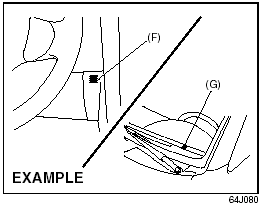
Be careful not to cover the interior temperature sensor (F) located between the steering wheel and the climate control panel, or the solar sensor (G) located at the top of the driver’s side dashboard.
These sensors are used by the automatic system to regulate temperature.
Manual operation
You can manually control the climate control system. Set the selectors to the desired positions.
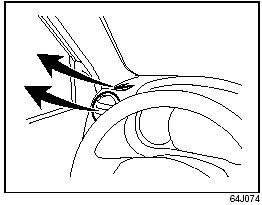
NOTE:
If you need maximum defrosting:
• set the defrost switch (5) to “DEFROST”
(the air conditioning system will come on
and the “FRESH AIR” mode will be
selected automatically),
• set the blower speed selector to HIGH,
• adjust the temperature selector to the
“HI” indication on the LCD display, and
• adjust the side outlets so the air blows
on the side windows.
Maintenance
If you do not use the air conditioner for a long period, such as during winter, it may not give the best performance when you start using it again. To help maintain optimum performance and durability of your air conditioner, it needs to be run periodically.
Operate the air conditioner at least once a month for one minute with the engine idling. This circulates the refrigerant and oil and helps protect the internal components.
Your air conditioner is equipped with air filters.
Clean or replace them as specified in the “Maintenance Schedule” in the “INSPECTION AND MAINTENANCE” section.
Have this job done by your SUZUKI dealer as the lower glove box must be lowered for this job.
NOTE:
Your vehicle uses the air conditioning
refrigerant HFC-134a, commonly called
“R-134a”. R-134a replaced R-12 around
1993 for automotive applications. Other
refrigerants are available, including recycled
R-12, but only R-134a should be used
in your vehicle.
CAUTION:
Using the wrong refrigerant may
damage your air conditioning system.
Use R-134a only. Do not mix or replace the R-134a with other refrigerants.
See also:
Spark Plugs
Spark Plugs
65D180
You should inspect spark plugs periodically
for carbon deposits. When carbon accumulates
on a spark plug, a strong spark
may not be produced. Remove carbon
deposits with a w ...
Ride & Handling
If you've been shopping around and test-driving small crossovers, you're
probably already familiar with the firm ride many of them offer. There are only
a handful of models in the segment, like th ...
On-Road
In everyday driving, the Equator rides and handles the way a midsize pickup
should. It's smoother than a full-size and easier to park, but without V-8
power. All the test units were 4x4s; we hoppe ...
